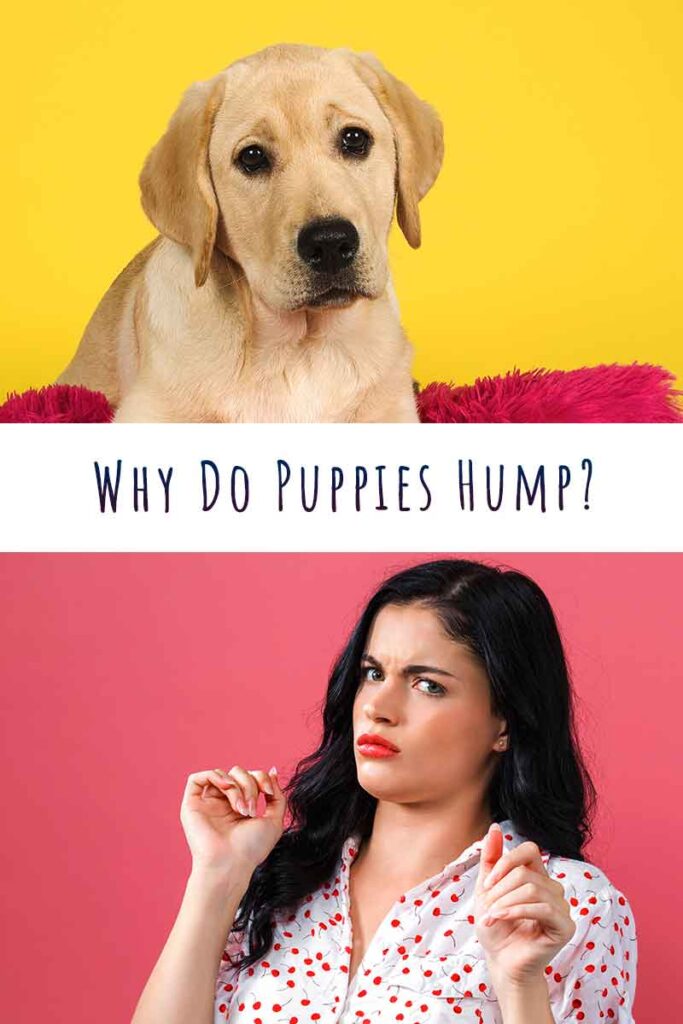
Why do puppies hump you, their toys, the furniture, each other, and all kinds of other things besides?
Humping and mounting behavior is a normal part of growing up for lots of young dogs.
There are lots of reasons for it, and in most cases it is not a cause for concern.
There are also some very simple ways to stop humping from becoming an annoying habit, if it is bothering you.
Why do puppies hump?
Lots of puppies – both boys and girls – practice mounting and humping as puppies.
In fact, one survey of puppy parents in the United States revealed that approximately 1 in 5 puppies display mounting or humping behavior.

Puppies may hump a wide variety of targets, or return to the same one over and over again.
Things puppies frequently hump include:
- other dogs
- members of their human family
- visitors
- stuffed toys
- blankets
- cushions
And their reasons for humping are as varied as the things that they mount.
Puppy parents frequently feel embarrassed by their puppy humping things, because we tend to perceive it as sexual behavior.
But in fact for lots of puppies, sex has nothing to do with it.
(Which doesn’t mean you have to just turn a blind eye while your pup humps your neighbor’s leg – but we’ll come to that in a minute.)
When do dogs start humping?
Puppies may mount their littermates whilst they’re still young enough to all be with their mom.
But humping is typically a bigger problem in older dogs than puppies.
Most owners notice a significant increase in the frequency of humping at the point of sexual and social maturity – around 12 to 14 months old.
So, let’s look at all the possible reasons why puppies younger than that hump.
1. Play
For a lot of puppies, mounting and humping is simply another way of playing.
Puppies who haven’t started puberty yet have no understanding of humping as a sexual behavior.
They do it in the same way that they bark and growl at one another (without meaning it aggressively) and shake toys in their mouths (without expecting to kill them).
Some people do think that they are hardwired to do it during play, as practice for the more serious business of mating in future.
But for the moment, it’s just good fun.
2. To release pent up energy
Puppies have more energy than they know what to do with!
They often flit from one activity to the next, losing interest in one thing then launching into something else in very quick succession.
For some puppies, humping is just something else they can do to channel their energy.
This is supported by a study of dog behavior which found that dogs that lead largely indoor lifestyles are more likely to hump than dogs who spend most of their time outdoors.
3. Excitement
In a similar vein, some behaviorists think that humping can be an expression of over excitement.
Dogs tend to be very tactile greeters. We’ve all been around a puppy who is so enthusiastic about a new visitor that they jump all over them.
In fact, jumping up behaviors and humping behaviors tend to be closely linked, and puppies tend to do both, or neither.
So when an excitable puppy who tends to jump up at people also humps them, it’s simply an expression of emotions running high.
4. Stress or anxiety
Some researchers have also proposed that puppies may use humping to try and displace feelings of stress or anxiety.
They have also linked excessive humping to increased aggression in other species, and proposed that the two might be biologically linked in multiple mammals.
This makes sense, because most aggression in dogs is fear-based too.
But puppies very rarely use aggression when they’re scared (why pick a fight they’re too small to win?) but they might use other coping mechanisms, like humping, to distract themselves.
Stressed or anxious humping can also turn into compulsive humping – when dogs form an abnormal relationship with doing it, and can’t stop themselves anymore.
5. To get attention
All the kinds of humping we’ve looked at so far have been instinctive – puppies do them without thinking about why they’re doing them.
But puppies can also consciously learn to use humping behaviors to get attention.
Puppies love attention. Even being told off is better than being totally ignored. After all, they know that their very survival depends upon us not forgetting about them!
They also belong to a social species – they’re hardwired to form social bonds and seek out interaction with their social group.
So how do you react when your puppy humps you? If you react by giving them attention, they may learn to use humping as an attention seeking behavior.
6. To sire puppies
Whilst the vast majority of puppy humping is non-sexual, male dogs can be sexually mature and capable of siring puppies from as young as 5 months old.
So it might sound obvious, but if your male puppy is mounting a female puppy at the dog park, check that there’s no possibility of her being in season!
7. Medical reasons
Whilst uncommon, sudden changes in humping behavior can sometimes be explained by an underlying medical reason.
For example, a puppy who feels itchy due to allergies, or who has a urinary tract infection, might mount things to try and rub the affected area.
8. It feels good
Finally, when puppies hump for no other apparent reason, it’s likely that they’re just doing it because it feels good.
In particular, lots of people report that their puppies are especially likely to hump toys, blankets and cushions towards the end of the day, and not long before they go to bed for the evening.
It’s likely that they do this because humping is a pleasant sensation, and an effective way of self-soothing when they start to feel tired.
Why do female puppies hump?
We typically associate mounting behaviors with male dogs, and it’s true that male puppies are more likely to hump and mount than female puppies.
However, female puppies might also hump for all the reasons which aren’t sexual:
- Play
- To release energy
- Excitement
- To distract themselves from feelings of stress or anxiety
- To get attention
- Medical reasons
Is it normal for puppies to hump?
There are lots of benign reasons why puppies hump, and only a few to worry about.
Scientists have also observed some trends in humping behaviors.
For example small breeds are more likely to mount and hump than larger breeds.
And dogs in single-dog households are more likely to hump than dogs in multi-dogs households.
Although, the reasons for these patterns aren’t fully understood yet.
Should I stop my puppy humping
Puppy humping behaviors are natural, and mostly harmless.
Puppies who hump a favorite blanket or cuddly toy no more than once or twice a day can usually be left to it.
But, if your puppy is humping something (or someone!) they shouldn’t, and it is unwanted, or socially embarrassing, there are things you can do to break the habit.
If they are humping through stress and anxiety, it’s also our job to help them overcome those underlying feelings.
Being proactive to reshape their behavior before it’s very established works better than letting it become an ingrained habit first.
So, here are our top tips for managing puppy humping behavior:
1. Don’t punish it
Punishing puppies for unwanted behavior gets you exactly nowhere.
And it damages your bond with them so that your relationship and your training will be compromised in future.
You can read more about why we don’t recommend punishment for dogs or puppies in this article.
2. Look for patterns
What’s happening around your puppy when they start humping?
Is it always at the dog park, or when people visit, or at the same time of day.
Or has it started and increased very rapidly, out of the blue?
These patterns give clues about their emotional state when they hump, and how to handle it.
3. Don’t reinforce it
Try to avoid making a fuss and giving your puppy a lot of attention when they hump things.
This prevents it turning into an attention seeking behavior in future, or reinforcing and attention-securing value it already has.
If your puppy is humping you, calmly remove yourself from their reach whenever they start.
Baby gates on doorways are really helpful for achieving this.
4. Use redirection
As a puppy parent, you’re probably already familiar with redirecting puppies to suitable toys when they chew your shoes.
Well you can apply the same principle to humping.
If they hump something they shouldn’t in order to burn off energy or self-soothe, redirect them to a toy or blanket which you don’t mind them humping.
5. Reward alternative behaviors
If your puppy humps people as an over excited greeting, teach them an alternative behavior, like sitting for treats.
6. Build their confidence
Humping as a displacement activity for feeling of fear or anxiety is a form of reactivity.
Reactive puppies need help to change their emotional reaction to the thing they fear.
This process is called counter conditioning.
You can read a little more about the principles of it here, but you might benefit from asking a trained force-free behaviorist to help you apply them in practice.
6. Seek veterinary attention
Finally, for sudden changes in humping behavior, always ask a vet to check them for underlying medical reasons.
Will neutering fix it?
Because we tend to view humping as a sexual behavior, there’s a common misconception that neutering will eradicate it.
But whilst there are some indications that neutering reduces humping behavior in male dogs, researchers have stressed that it’s not guaranteed, and there’s not enough evidence yet to predict the odds of it working.
In female dogs, there’s no evidence that spaying reduces humping behavior at all, and some research has even suggested it can increase humping behavior.
There are also lots of other factors to consider before neutering a dog, and it should never be undertaken lightly without weighing up all the potential advantages and disadvantages.
Why do puppies hump you?
Puppies hump for lots of reasons, but most commonly as a form of play.
You can prevent humping becoming socially embarrassing by redirecting your puppy to something discreet, or teaching them an alternative behavior to offer at the times they frequently attempt humping.
If your puppy’s humping increases very suddenly, or seems out of control, a veterinarian or a behaviorist can help you.
References
Didehban et al. Problematic behaviors in companion dogs: A survey of their prevalence and associated factors. Journal of Veterinary Behavior. 2020.
Dinwoodie et al. Demographics and comorbidity of behavior problems in dogs. Journal of Veterinary Behavior. 2019.
Dinwoodie et al. An Investigation into the Impact of Pre-Adolescent Training on Canine Behavior. Animals. 2021.
England. Dog Breeding, Whelping and Puppy Care. John Wiley & Sons. 2012.
Gazzano et al. The prevention of undesirable behaviors in dogs: effectiveness of veterinary behaviorists’ advice given to puppy owners. Journal of Veterinary Behavior. 2008.

Free Training Tips
Get Pippa's free dog training tips delivered to your inbox

 How To Stop Your Puppy Biting Leash Handles, Attachments And Straps
How To Stop Your Puppy Biting Leash Handles, Attachments And Straps